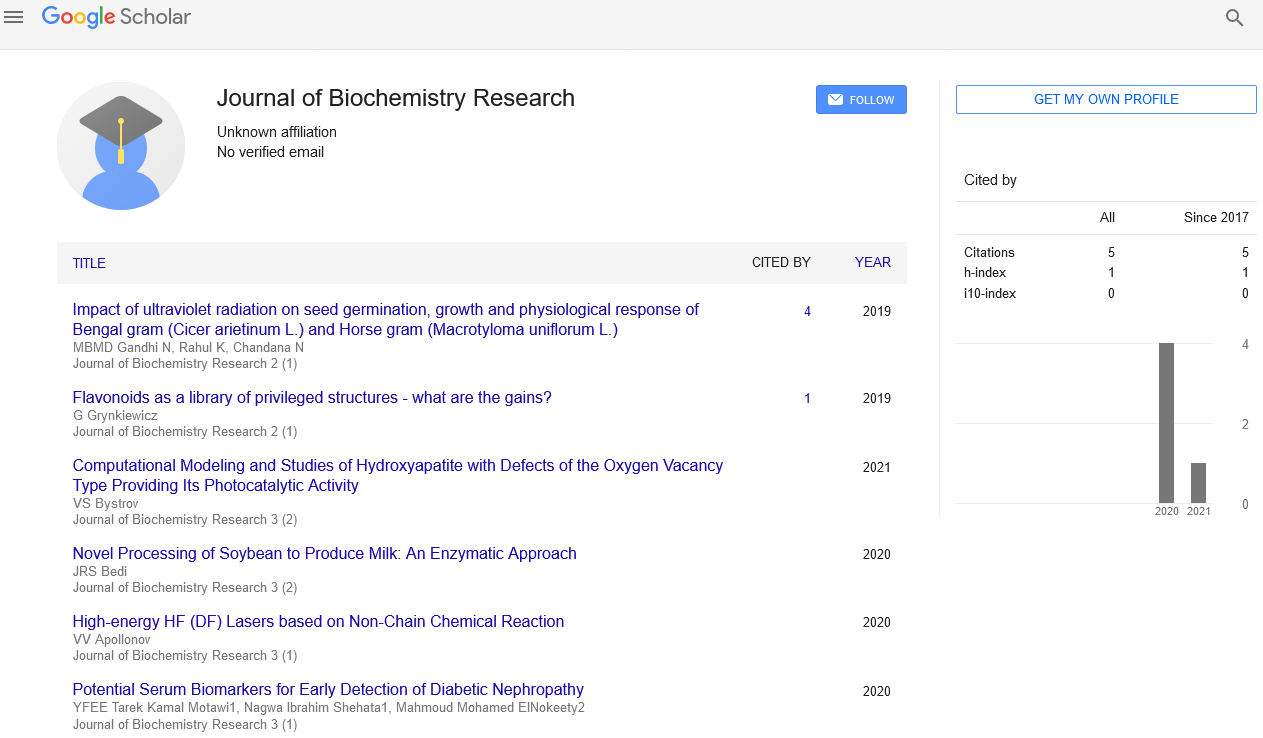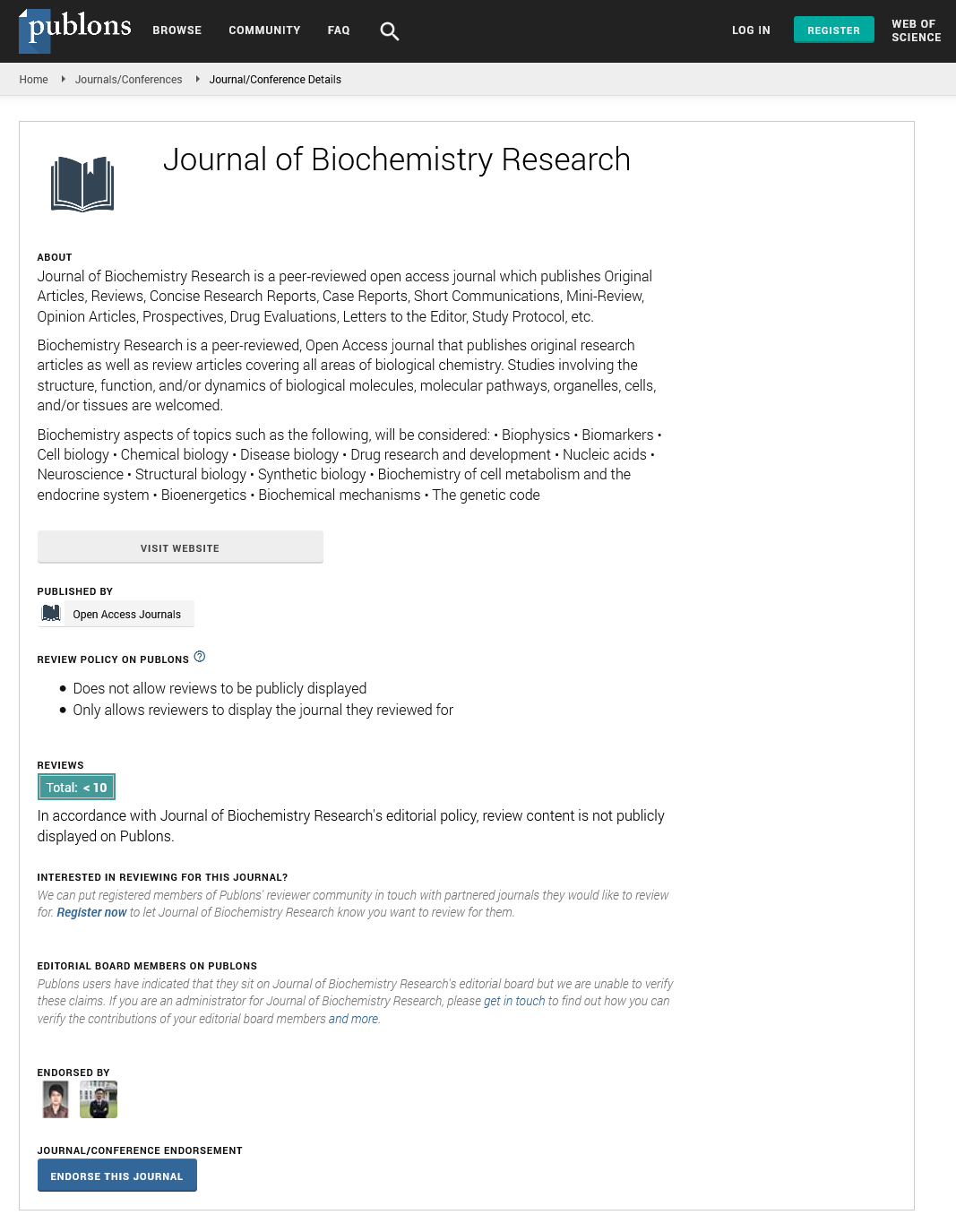Editorial - Journal of Biochemistry Research (2023) Volume 6, Issue 2
A Review Dynamics of Biological Molecules
Dr. Madhu Tiwari*
Department of Molecular Biological and Stem Cell and Research, India
Department of Molecular Biological and Stem Cell and Research, India
E-mail: XXX
Received: 03-April-2023, Manuscript No. oabr-23-96858; Editor assigned: 05-April-2023, PreQC No. oabr-23- 96858; Reviewed: 19-April-2023, QC No. oabr-23-96858; Revised: 21-April-2023, Manuscript No. oabr-23-96858 (R); Published: 28-April-2023; DOI: 10.37532/ oabr.2023.6(2).29-31
Abstract
The study of the dynamics of biological molecules is crucial to understanding the behavior and function of living organisms at a molecular level. This field encompasses a broad range of research, from the movement and interactions of individual molecules to the collective behavior of complex systems. Key topics in the dynamics of biological molecules include protein folding, enzymatic catalysis, and signal transduction. These processes are governed by a complex interplay of molecular forces and environmental factors, and are influenced by a wide range of biological and physical factors. Recent advances in experimental techniques and computational methods have enabled researchers to gain new insights into the dynamics of biological molecules, and have provided a deeper understanding of the fundamental principles that govern these processes. This research has important implications for a wide range of fields, including drug discovery, biotechnology, and the development of new materials and devices.
Keywords
Dynamics of biological molecules • Living organisms • Molecular level • Enzymatic catalysis • Signal transduction • Protein folding • Materials and devices • Biotechnology
Introduction
The dynamics of biological molecules are critical to understanding the functioning of living systems. Biological molecules are the building blocks of life and include proteins, nucleic acids, lipids, and carbohydrates. These molecules interact with each other in complex ways to carry out a variety of biological functions, such as catalyzing chemical reactions, transmitting signals, and storing genetic information. Understanding the dynamics of these molecules is essential to unlocking the secrets of life and developing new treatments for diseases [1].
Proteins are perhaps the most important biological molecules, as they carry out a vast array of functions in living systems. Proteins are composed of long chains of amino acids that are folded into complex 3D structures [2]. The precise shape of a protein is critical to its function, as it determines how the protein interacts with other molecules in the cell. The dynamics of proteins are complex and are influenced by a variety of factors, including temperature, pH, and the presence of other molecules.
One important aspect of protein dynamics is the process of protein folding. Proteins begin as long chains of amino acids that are unfolded and must be folded into their final 3D structure [3]. The process of protein folding is driven by a balance of attractive and repulsive forces between amino acids. In some cases, proteins may misfold, leading to the formation of aggregates that can be toxic to cells. Understanding the mechanisms that govern protein folding is essential to developing new treatments for diseases caused by protein misfolding, such as Alzheimer’s and Parkinson’s disease [4].
Another important aspect of protein dynamics is the process of protein binding. Proteins often interact with other molecules in the cell, such as other proteins, DNA, or small molecules. These interactions are typically transient, meaning that the proteins bind and unbind rapidly. The dynamics of protein binding are critical to understanding how proteins function in biological systems [5]. For example, enzymes catalyze chemical reactions by binding to substrate molecules and facilitating the conversion of the substrate into a product. Understanding the dynamics of enzyme-substrate binding is essential to developing new drugs that target specific enzymes [6]. Nucleic acids, such as DNA and RNA, are another important class of biological molecules. These molecules store genetic information and are responsible for transmitting this information from one generation to the next [7]. The dynamics of nucleic acids are critical to understanding how genetic information is stored and transmitted. For example, DNA must be replicated accurately before cell division to ensure that each daughter cell receives a complete copy of the genetic information. Understanding the mechanisms that govern DNA replication is essential to developing new treatments for diseases caused by mutations in DNA, such as cancer [8]. Lipids are another important class of biological molecules. These molecules form the structural basis of cell membranes and are critical to maintaining the integrity of cells. The dynamics of lipids are complex and are influenced by a variety of factors, including temperature, pH, and the presence of other molecules [9]. Understanding the dynamics of lipids is essential to understanding how cells function and how they respond to changes in their environment. Carbohydrates are also important biological molecules. These molecules are used by cells as a source of energy and play a variety of other roles in biological systems. The dynamics of carbohydrates are critical to understanding how cells obtain and use energy. For example, the breakdown of glucose, a common carbohydrate, is a critical source of energy for cells. Understanding the mechanisms that govern glucose metabolism is essential to developing new treatments for diseases such as diabetes [10].
Conclusion
The dynamics of biological molecules are critical to understanding the functioning of living systems. Proteins, nucleic acids, lipids, and carbohydrates interact with each other in complex ways to carry out a variety of biological functions. Understanding the dynamics of these molecules is essential to unlocking the secrets of life and developing new treatments for diseases. The dynamics of biological molecules play a critical role in the function and behavior of living systems. The movements and interactions of molecules such as proteins, DNA, and RNA are essential for processes such as metabolism, signal transduction, and gene expression. Understanding the dynamic behavior of these molecules is essential in fields such as biochemistry, molecular biology, and biophysics. Recent advances in experimental techniques, such as single-molecule microscopy, NMR spectroscopy, and X-ray crystallography, have enabled researchers to study the dynamics of biological molecules with unprecedented detail. These techniques have provided insights into the structural changes and movements that occur during biological processes. Computational modeling and simulations have also become increasingly important in understanding the dynamics of biological molecules. These methods enable researchers to simulate the behavior of molecules and predict their interactions with other molecules. Overall, the study of the dynamics of biological molecules is a rapidly evolving field with broad implications for biotechnology, drug discovery, and medicine. As we continue to improve our understanding of these complex systems, we will be better equipped to tackle the challenges of developing new treatments and technologies for a wide range of diseases and conditions.
References
- Harrison, Paul. How shall I say it? Relating the nonrelational .Environ. Plan A. 39, 590-608 (2007).
- Jackson, Peter. The multiple ontologies of freshness in the UK and Portuguese agri food sectors. Trans Inst Br Geogr. 44, 79-93 (2019).
- Tetila EC, Machado BB et al. Detection and classification of soybean pests using deep learning with UAV images. Comput Electron Agric. 179, 105836 (2020).
- Kamilaris A, Prenafeata-Boldú F. Deep learning in agriculture: A survey.Comput Electron Agric.147, 70-90 (2018).
- Suto J. Condling moth monitoring with camera-equipped automated traps: A review. Agric. 12, 1721 (2022).
- Dwyer, Claire. ‘Highway to Heaven’: the creation of a multicultural, religious landscape in suburban Richmond, British Columbia. Soc Cult Geogr. 17, 667-693 (2016).
- Imrie, Rob. Industrial change and local economic fragmentation: The case of Stoke-on-Trent. Geoforum. 22, 433-453 (1991).
- Jackson, Peter. The multiple ontologies of freshness in the UK and Portuguese agri‐food sectors. Trans Inst Br Geogr. 44, 79-93 (2019).
- Brunelli D, Polonelli T, Benini L et al. Ultra-low energy pest detection for smart agriculture. IEEE Sens J. 1-4 (2020).
- Dora, Veronica Della. Infrasecular geographies: Making, unmaking and remaking sacred space. Prog Hum Geogr. 42, 44-71 (2018).
Indexed at, Google Scholar, Crossref
Indexed at, Google Scholar, Crossref
Indexed at, Google Scholar, Crossref
Indexed at, Google Scholar, Crossref
Indexed at, Google Scholar, Crossref


